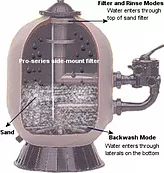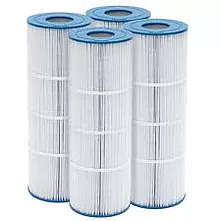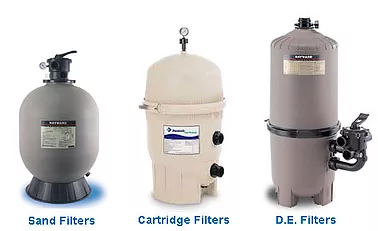Pool Filter Selection: Sand or DE or Cartridge?
September, 30 2015
Pool Filter Selection: Sand or DE or Cartridge? That is the question we are going to try to help answer today. When it comes to filtering your swimming pool water there are 3 different types of pool filters that are used. Sand, Diatomaceous Earth (DE) and Cartridge Filters. People will give a different opinions on their preference of pool filter. I will explain the pros and cons of each inground pool filter type. At the end you will have enough information to make an educated decision on which pool filter is best for you and your swimming pool.
All pool filters remove dirt through a screening process which I will explain for each one. Swimming pool filtersare rated, or sized in 2 ways, filter area and filter rate. The filter area is the total area or square feet of filter media of surface of which water can flow through. Filter rate is measure in gallons per minute, per square foot of filter area.

Sand Filters
The oldest form of filtration for a swimming pool is sand filters. It work by filtering water through a layer of #20 US grade silica sand. The dirt particles in the water are trapped and held in the very small openings between the fine grains of sand. With a sand filter water enters the filter through the top of the filter. Then it’s evenly distributed across the surface area of the sand bed, and pushed to the bottom of the filter.
A new sand filter or a sand filter with new clean sand will begin to work better and filter to a smaller particle size. As the filter gets dirtier the flow of water through the filter will decrease because of the increase in pressure across the sand bed. As the flow rate decreases, the pressure rate increases. When the pressure rate increases 7 or 8 psi above the starting pressure, the filter needs to be backwashed. Backwashing causes the water to flow in reverse, upward through the sand bed and out to waste.
Sand filters are probably the most common type of filter used and also typically the least expensive type of filter to purchase. On the downside, they are the least in terms of filtering ability, they filter down to a particle size of 20-40 microns. Besides backwashing the filter there is very little maintenance that is required you just need to change the sand about every 5 years.

DE Filters
Diatomaceous Earth is a much different type of filter media used to filter swimming pool water. Unlike a sand filter in which the sand media in the filter is cleaned and reused the DE powder is discarded along with the dirt when the filter cycle is completed and you backwash the filter. Every time you backwash a DE filter you need to add more DE powder through your skimmer. There are 2 different types of DE filters the vertical grid filter and the regenerative filters also known as bump filters. In both cases, the DE powder coats the elements inside, and traps the dirt as the water flows through the powder.
DE filters have the advantage of filtering the pool water to smallest microns and will keep the water cleaner than a sand filter or a cartridge filter. The disadvantage of this type of filter is that it requires the most amount of maintenance. DE filters do require DE powder after backwashing. Some states require a separation tank when using a DE filter to keep DE powder from streams or sewers. Also with a DE Filter you typically have to take apart the filter once or twice per year, to clean the filter grids or tubes with water. Typically a good hosing is all that’s will get them clean.
This filter definitely requires the most of maintenance but it will filter the water to the smallest micron size, around 2-3 microns. DE filters are the most expensive to purchase. They require more maintenance than other types, they are the best form of filtration available.

Cartridge Filters
Cartridge filters use a pleated polyester cartridge to filter the water. One advantage, this type of filters no multiport valve necessary so the plumbing of the filter is a little easier. Since there is no multiport valve with a cartridge filter there is obviously no backwashing. This will save water and money as you are not constantly backwashing chemicals out of the swimming pool. Cartridge filters are the most environmentally friendly because it conserves water, and no chemicals or DE mess will be left behind.
The cartridge filter will filter the water to almost as small as microns as DE filter and with less maintenance because you can rinse them easily with a garden hose. A big disadvantage of a undersized cartridge filter is that you’d need to clean the cartridge fairly often, but a larger filter, with a cluster of 3 or 4 cartridges inside, you normally only have to clean the filter every 4-6 months.
To clean the cartridges you open up the filter tank and take cartridges out and spray them down with a hose. Cleaning the cartridges is a lot easier than cleaning DE filter grids. Both do require patience and attention to detail.
Conclusion:
Pool Filter Selection: Sand or DE or Cartridge? Hopefully you feel more comfortable answering this now. There are advantages and disadvantages to each type of inground pool filter. Everyone has a different opinion of which is better within the pool industry. They’re all good, as long as it’s not too small. When it comes to a cartridge filter bigger is always better for less maintenance. When it comes to the DE and sand filters you must size the filter according to your pool pump. This is so the water flow rate meets design rate of flow. But again, for DE and Sand, bigger is also usually better. A larger filter will give you longer filter runs, with less overall maintenance required. It also makes fast work of cleaning up poor water conditions or helps prevent them in the first place.




